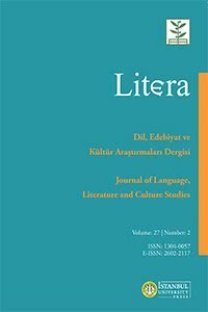Haruki Murakami’nin Hipertextlerinde Performatif İşlevli Hikâye Anlatımı: Dün ve Şehrazad
Storytelling with Actional Function in Haruki Murakami’s Hypertexts: Yesterday and Scheherazade
Genette, Murakami, Hypertext, Storytelling actional function,
___
Allen, G. (2000). Intertextuality. London: Routledge.Aronson, L., Tenenbaum, S. & Roures, J. (Producers) & Allen, W. (Director). (2011). Midnight in Paris. United States: Versatil Cinema.
Chambers, R. (1984). Story and situation: narrative seduction and the power of fiction. Minneapolis: Manchester University Press.Coleredge, S. T. (1982 [1878) The rime of the ancient mariner. New York: Dover Publishing.
Eco, U. (1989). The open work. Trans. A. Cancogni. Cambridge: Harvard University Press.
Genette, G. (1982) Narrative discourse: an essay in method. Trans. Jane E. Lewin. Ithaca: Cornell University Press.Genette, G. (1992 [1979]) The Architext. Trans. Jane E. Lewin. Ithaca: Cornell University Press.
Genette, G. (1997 [1982]) Palympsests, narrative in the second degree. Trans. C. Newman & C. Doubinsky. Lincoln: University of Nebraska Press.
Irwin, R. (2004). The Arabian Nights: A companion. London: Tauris Park Paperbacks.
Joyce, J. (2016 [1922]). Ulysses. London: Penguin.
Jullien, D. (2019). Bridge Essay: Orientalia. A Companion to World Literature. Ed. K. Seigneurie. John Wiley & Sons Ltd.
Kristeva, J. (1989). Black sun: depression and melancholia. New York: Columbia University Press.
Mathers, E.P., Ed. (2004 [1964]). The book of the thousand nights and one night (vol. 1), London: Routledge.
Strecher, M.C. & Thomas, P.L. Eds. (2016) Haruki Murakami. Critical literacy teaching series: challenging authors and genres. Rotterdam. Sense Publishers.
McCartney, P. & Lennon, J. (1965). Yesterday [Lyrics]. On the album Help!. Retrieved from https://genius.com/The-beatles-yesterday-lyrics
Mukherjee, S. & Swamy, S.K. (2019). Redefining Masculinity in Haruki in Murakami’s Men Without Women. Shanlax International Journal of English, vol. 8, no. 1, pp. 67–70.
Murakami, H. (2010) “Reality A and reality B. New York Times.” Global Agenda 29 Oct. 2010.
Murakami, H. (2017 [2014]) Men without women. Trans. Philip Gabriel. New York: Vintage.
Murakami, H. (2000). Norwegian wood. Trans. Jay Rubin. New York: Vintage Vintage.
Murakami, H. (2005). Kafka on the Shore. Trans. Philip Gabriel. New York: Vintage.
Poole, S. (2011). “1Q84 by Haruki Murakami – Review.” Guardian 18 Oct. 2011.
Rimmon-Kenan, S. (2002 [1983]) Narrative fiction: contemporary poetics. London: Routledge.
Strecher, M. (2002). Dances with sheep: The quest for identity in the fiction of Murakami Haruki.
Michigan, MI: University of Michigan.
Yeung, H. (2014). More than the Sum of its Parts’: Popular Music, Gender, and Myth in Haruki Murakami’s Fiction. Transnational Literature, Vol. 7 no. 1, November Issue.
Yeung, V. (2016): Stories Within Stories: A Study of Narrative Embedding in Haruki Murakami’s 1Q84, Critique: Studies in Contemporary Fiction.
Waugh, P. (1994). Metafiction: The theory and practice of self-conscious fiction. London: Methuen.
- Yayın Aralığı: Yılda 2 Sayı
- Yayıncı: İstanbul Üniversitesi
Polysemy and Dichotomy of the Bridge in Ödön von Horváth’s Hin und her
Çeviri Odaklı Transdisipliner Pratikler: Organizmalardan Artırılmış Veri ve Çeviri Heykellerine*
Emine DEMİREL, Zeynep GÖRGÜLER
Fransızcadan Türkçeye Çeviride İlgi Eyleminin Dolaylı Yollarla Çevirisi
Todd Phillips’in Joker Filmine Jungcu ve Nietzscheci bir Yaklaşım
Müziğin Ruhunu Yansıtan Anlatı Örnekleri: Ravel ve Dünyanın Tüm Sabahları
The Shattering Symmetries between the Imaginary and the Symbolic in Carter’s The Magic Toyshop
“The Greatest Empresse of the East”: Hurrem Sultan in English Restoration Drama
